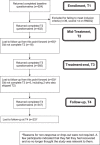Psychological covariates of longitudinal changes in back-related disability in patients undergoing acupuncture
- PMID: 24901897
- PMCID: PMC4323559
- DOI: 10.1097/AJP.0000000000000108
Psychological covariates of longitudinal changes in back-related disability in patients undergoing acupuncture
Abstract
Objectives: To identify psychological covariates of longitudinal changes in back-related disability in patients undergoing acupuncture.
Materials and methods: A longitudinal postal questionnaire study was conducted with data collection at baseline (pretreatment), 2 weeks, 3, and 6 months later. A total of 485 patients were recruited from 83 acupuncturists before commencing acupuncture for back pain. Questionnaires measured variables from 4 theories (fear-avoidance model, common-sense model, expectancy theory, social-cognitive theory), clinical and sociodemographic characteristics, and disability. Longitudinal multilevel models were constructed with disability over time as the outcome.
Results: Within individuals, reductions in disability (compared with the person's individual mean) were associated with reductions in: fear-avoidance beliefs about physical activity (β=0.11, P<0.01) and work (β=0.03, P<0.05), catastrophizing (β=0.28, P<0.05), consequences (β=0.28, P<0.01), concerns (β=0.17, P<0.05), emotions (β=0.16, P<0.05), and pain identity (β=0.43, P<0.01). Within-person reductions in disability were associated with increases in: personal control (β=-0.17, P<0.01), comprehension (β=-0.11, P<0.05) and self-efficacy for coping (β=-0.04, P<0.01). Between individuals, people who were less disabled had weaker fear-avoidance beliefs about physical activity (β=0.12, P<0.01), had more self-efficacy for coping (β=-0.07, P<0.01), perceived less severe consequences of back pain (β=0.87, P<0.01), had more positive outcome expectancies (β=-0.30, P<0.05), and appraised acupuncture appointments as less convenient (β=0.92, P<0.05).
Discussion: Illness perceptions and, to a lesser extent, self-efficacy and expectancies can usefully supplement variables from the fear-avoidance model in theorizing pain-related disability. Positive changes in patients' beliefs about back pain might underpin the large nonspecific effects of acupuncture seen in trials and could be targeted clinically.
Conflict of interest statement
Supported by Arthritis Research UK (Career Development Fellowship 18099), Chesterfield, UK. G.T.L.’s post is supported by a grant from the Rufford Maurice Laing Foundation. The remaining authors declare no conflict of interest.
Figures
References
-
- Breivik H, Collett B, Ventafridda V, et al. Survey of chronic pain in Europe: prevalence, impact on daily life, and treatment. Eur J Pain. 2006;10:287–333. - PubMed
-
- Savigny P, Kuntze S, Watson P, et al. Low Back Pain. Early Management of Persistent Non-Specific Low Back Pain. NICE Clinical Guideline. 2009:88 edLondon: National Collaborating Centre for Primary Care and Royal College of General Practitioners; Available at: http://www.nice.org.uk/CG88. - PubMed
-
- MacPherson H, Sinclair-Lian N, Thomas K. Patients seeking care from acupuncture practitioners in the UK: a national survey. Complement Ther Med. 2006;14:20–30. - PubMed
-
- Brinkhaus B, Witt CM, Jena S, et al. Acupuncture in patients with chronic low back pain—a randomized controlled trial. Arch Intern Med. 2006;166:450–457. - PubMed
Publication types
MeSH terms
Grants and funding
LinkOut - more resources
Full Text Sources
Medical


